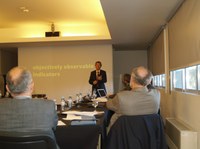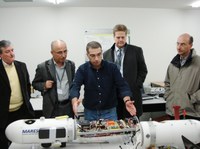INESC TEC – an institute to be proud of
Meteoric expansion
It has been three years since the last Scientific Advisory Board visit and this year they returned with more members to evaluate INESC TEC’s science. The key questions for this SAB visit included the relevance of the scientific production, the quality of the human resources and INESC TEC’s work with industry and companies. Over two intense days the Board members had the opportunity to see the INESC TEC Units and the Privileged Partner HASLab up-close.
The SAB’s impressions could not have been more positive. The Board concluded that INESC TEC has grown dramatically since the last visit and has been able to create a unique style that promotes scientific competencies and uses them to address concrete problems in the Portuguese society and the economy. According to the SAB, this growth should be followed by a period of maturity to consolidate the vision, the mission and best practices and strengthen what has already been achieved.
Furthermore, the SAB was impressed with the level of maturity, style and general capacity of the INESC TEC community in key aspects, such as the increase in production and the role that the institute has taken on in developing socially relevant research and technology. The Board concluded that, “bringing together all of these competencies is truly an art”.
The science and the people make the Institute
 José Carlos Príncipe (Portugal, lecturing in the US), Tomaz Goméz (Spain), Volker Stich (Germany), Leonardo Chiarglione (Italy), José Fortes (Portugal, lecturing in the US), and Maarten von Someran (Holland), along with the new members Daniel Mossé (Brazil), José Luís Fiadeiro (Portugal, lecturing in the UK) and Steven Nichols (USA) participated in this evaluation covering 2009-2011. When choosing Board members with internationally recognised expertise, the Board of Directors at INESC TEC aimed for a large number of experts from various countries and scientific areas and from different types of organisations to ensure a more credible assessment.
José Carlos Príncipe (Portugal, lecturing in the US), Tomaz Goméz (Spain), Volker Stich (Germany), Leonardo Chiarglione (Italy), José Fortes (Portugal, lecturing in the US), and Maarten von Someran (Holland), along with the new members Daniel Mossé (Brazil), José Luís Fiadeiro (Portugal, lecturing in the UK) and Steven Nichols (USA) participated in this evaluation covering 2009-2011. When choosing Board members with internationally recognised expertise, the Board of Directors at INESC TEC aimed for a large number of experts from various countries and scientific areas and from different types of organisations to ensure a more credible assessment.
The visit was important for the whole INESC TEC universe, not just the managers but also those who produce the science. The SAB seemed pleased that INESC TEC had implemented their past suggestion, such as creating a successful infrastructure for technology transfer and improving inter-unit cooperation with a notable increase in scientific production. Furthermore, INESC TEC’s international image has significantly improved, in terms of collaboration with Europe and the US and the Board has noted that this is something which can be explored further.
The SAB highlighted INESC TEC’s real contribution towards making Portuguese industry more competitive, generating wealth and improving the financial situation. The SAB also highlighted various integrated and innovative projects, the strategic vision for growth (inside and outside of Portugal), efficient support and management services and the very active team of both young and experienced researchers at INESC TEC.
INESC TEC Units “under the microscope”
 The SAB made suggestions and evaluated each Unit in turn and here are the results:
The SAB made suggestions and evaluated each Unit in turn and here are the results:
- The Telecommunications and Multimedia Unit (UTM)
UTM is well prepared to cope with issues relating to systems and they develop high-quality relevant technology, with a clear mission and well-defined objectives. They could develop competencies in other areas and they should align their activity with the needs of their clients.
- The Manufacturing Systems Engineering Unit (UESP)
UESP develops relevant topics in a wide range of production industries and their three-dimensional approach is ideal to structure and develop their scientific competencies and their industrial competencies (collaboration and working in networks, optimisation and decision, operation and management). They should see the need for innovation in companies as a starting point for commercial activity.
- The Optoelectronics and Electronic Systems Unit
UOSE has maintained its international reputation and expanded its areas of research. It must continue to explore its strong points in thin-films, sensors in energy, embedded systems and robotics to promote interdisciplinary collaboration with other Units.
- The Power Systems Unit (USE)
USE’s activity is highly consolidated with a high level of science and a registered increase in the R&D activities and the number of grant holders. They should focus on technology transfer to secure funding. The Units should continue to focus on internationalisation (Brazil and the US) because according to the SAB “this Unit has lots to show the US”.

- The Information and Computer Graphics Systems Unit (USIG)
USIG should continue to improve the quality and number of publications and the technical domains identified. It should develop a vision and mission, considering the benefits of engineering systems in collaboration with other INESC TEC Units.
- The Robotics and Intelligent Systems Unit (ROBIS)
ROBIS is a new interdisciplinary Unit with a wide range of activities and great potential for growth. They should define new areas of intervention, improve collaboration with units and other competencies and make the most of INESC TEC’s services to commercialise projects.
- The Innovation and Technology Transfer Unit (UITT)
UITT has introduced significant intellectual contributions to INESC TEC and they can help evaluate commercial potential. They should support the development of a patenting policy and continue to improve and increase their training sessions.
- The Laboratory of Artificial Intelligence and Decision Support (LIAAD)
LIAAD is an internationally recognised group with very positive scientific results. The Unit is well integrated with INESC TEC and all of the other Units and should attempt to balance science and applications.
- The Center for Research in Advanced Computing Systems (CRACS)
CRACS should continue their high-quality research, funding and academic work in the areas identified and they should develop a mission and vision for the Unit that coincides with the INESC TEC universe.
- The Unit of Industrial Management and Engineering (UGEI)
UGEI addresses multidisciplinary/industrially relevant research topics and has achieved a good balance between service engineering, decision support and performance management. They should look for competencies that are similar to those at INESC TEC.
- The Research Centre in Real-Time Computing Systems (CISTER)
CISTER is a centre with great potential, visibility and excellent researchers and it understands its limitations in technology transfer. As it develops within INESC TEC, it should identify shared competencies with other Units and make the most of the services the institute offers.
- The High-Assurance Software Laboratory (HASLab)
HASLab is a laboratory with excellent research credentials and fundamental applications and it has a good combination of different academic levels with involvement from young researchers. It has great potential to develop synergies with other Units and should use INESC TEC’s competencies to increase the number of international students they recruit.
SAB members have their say
BIP: Describe INESC TEC at this moment in one sentence:

Faramarz Farahi: INESC TEC is growing very quickly and that is exciting.

Leonardo Chiarglione: INESC TEC is like a rocket on the launching pad.

Daniel Mossé: I was really impressed with the structure and INESC TEC’s achievements and everything that you have achieved in this period. I came with a preconceived idea and I was very interested in your model and how you obtained 600 collaborators in just 4 years. I was pretty impressed.

José Fortes: This is an institution with a size comparable to the largest research centres in the world with incredible potential and admirable internal dynamics. The conclusion is positive. The [Scientific] Advisory Board was impressed and excited and there was a range of ideas that I think are good and could help INESC TEC be even better.

José Carlos Príncipe: My impression is very positive. INESC TEC has grown in an explosive way in the last few years. This can bring depth problems but in this case it has not. They have grown well, harmoniously, increasing everyone’s effort. This is great and you should be proud of what you do.

Steven Nichols: Compared to what it was several years ago, it’s a rapidly growing organisation that supports the research done here in Portugal and it is not only making contributions to make Portugal and Portuguese technology much more relevant in today’s society, but at the same time performing sound research.

Tomaz Goméz: I can say INESC TEC is a fantastic interface institution between research and industry in Portugal and all over Europe.

Volker Stich: Well, we have now seen INESC TEC for two days and we have seen plenty of details. I must admit they cover many technical and activity ideas and we are pretty impressed. And it has been a heavy work load for us getting all these broad and different intensified abilities of INESC TEC.

José Luís Fiadeiro: INESC TEC has the potential and has demonstrated evidence that it is able to make the transition from research to society and the economy.

Maarten van Someren: If I compare it with three years ago when I visited, INESC TEC has grown enormously, it has improved, it has broadened, it has become more of a coherent organisation. It’s a big advance. That’s how I see it.




